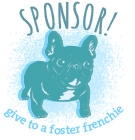FBRN Anesthesia Policy
(Download the PDF document here.)
If your Frenchie is to be anesthetized for ANY reason, make sure your veterinarian has experience with brachycephalic breeds. FBRN recommends the following anesthesia protocols for French bulldogs, based on our long (and sometimes unfortunately tragic) experience. Dr. Lori Hunt DVM and Dr. Dawn Ruben DVM have developed the Quick Guide to French bulldog Anesthesia.
French Bulldog Rescue Network Anesthesia Protocol
(* For your Veterinarian)
Requirement:
No food or water for 12 hours before surgery. This is crucial. A little bit of water a few hours before surgery isn’t bad, but if the dog eats on the morning of surgery, you need to postpone the surgery. Vomiting and aspiration can have devastating effects on a Frenchie.
Recommendations:
1) Do a clotting time, full blood chemistry work-up and a complete blood count before anesthesia.
2) Place an intravenous catheter prior to surgery.
3) Ideally, all dogs will be administered IV fluids during surgery.
4) Chest x-rays prior to surgery if the dog has had chronic breathing problems.
OPTIMAL
Use Propofol induction anesthetic, intubate (place a breathing tube in the trachea) and maintain on gas anesthetic (Isoflurane or Sevoflurane.) Some dogs may need Diazepam or Butorphanol to calm them down prior to giving Propofol.
Satisfactory Options
Ketamine combined with Diazepam (Valium)
Butorphanol (mild sedative for short procedures such as an x-ray.) This is also called Torbugesic or Torbutrol
Dexdomitor (reversible anesthetic/sedative)
Use with Caution
Thiopental
Telazol
Do Not Give Frenchies!
Acepromazine (sedative)
Pentobarbital (injectable anesthetic)
Xylazine (sedative)
Halothane (gas anesthetic)
Anesthesia Extras
(These would be in addition to the optimum anesthetic protocol listed above, and are recommended for longer procedures.)
Famotidine (Pepcid) or Ranitidine (Zantac) injection (helps cut down on nausea and post-op vomiting, decreases risk of aspiration.)
Dexamethasone can reduce post-op swelling and make recovery faster in cases where: the dog's throat is irritated from the ET tube, when the dog's palate is very long, or following palate surgery. A single injection can be given in these cases.
Intubation vs. Masking/Coning Down
EVERY brachycephalic dog that goes under anesthesia should have an endotracheal tube (ET) placed in his or her trachea. Always! The airway must be protected at all times. The endotracheal tube should be left in until after the dog is VERY awake, and is trying to chew it out. Use intravenous Propofol (or one of the other satisfactory drugs listed above) to induce anesthesia (which puts them under) and allows sufficient time to place the ET tube. From then on, anesthesia is maintained with Sevoflurane or Isoflurane.
Brachycephalic breeds, such as the Frenchie, should never be masked down for anesthesia. The problem with masking down Frenchies is that they can become very anxious, fight the mask and not breathe well. As most Frenchies have problems breathing in the first place, masking down just makes it worse, which results in lower oxygen levels. Ideally, injectable sedatives are used and an endotracheal tube is placed, which is then attached to an anesthetic machine. This gives them the optimum oxygen supply that they need.
French Bulldog Rescue Network Anesthesia Protocol developed by:
Dr. Lori Hunt, DVM
Dr. Dawn Ruben, DVM
French Bulldog Rescue Network · A 501 (c)(3) non-profit Organization
PO Box 4764 · Glen Allen, VA 23058-4764 · www.frenchbulldogrescue.org






